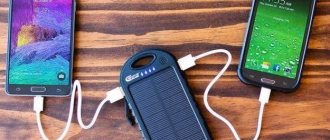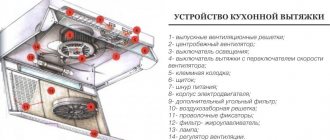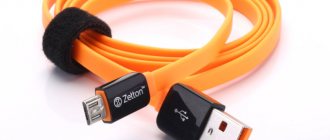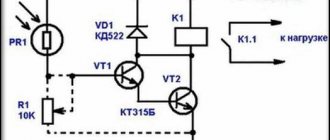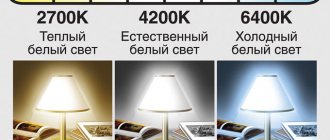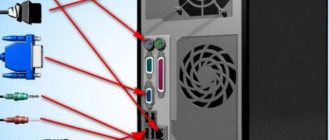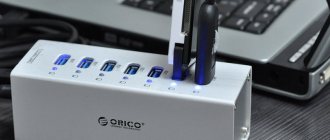There are more and more devices that work without electricity - this is a solar panel for charging a phone, tablet, digital camera and other portable devices. It runs on solar energy and is capable of recharging modern gadgets in any weather, far from civilization. The most popular models are discussed below.
TOP 6: Solar panel Goal Zero Nomad 7 (12301, 11800) for 2235 rubles
The monocrystalline panel charges any mobile gadget - navigator, smartphone, video camera, etc. It is protected from snow and moisture, so it will help out in any extreme situation.
Appearance
The foldable solar panel for charging your phone resembles a folder when folded. The device is secured to a backpack or tent using a convenient mount. There is a spacious mesh pocket at the back, which is convenient to place your charging device.
Exits
The device has three outputs:
- 6.5 V for branded Guide 10 devices;
- 12V;
- for mobile.
Charger
Thanks to the large capacity – 7 W, charging a phone lasts only 1-3 hours, a smartphone – 2-4. The duration depends on the lighting.
In a word, the device will not leave the user without communication, no matter where he is.
Price
Which solar charger to buy for your phone
Jetsun Solar Charger 16750mAh – Best Overall
Designed with the outdoor camper in mind, the Jetsun Portable Solar Charger
With two USB output ports, you can easily charge your smartphone and other portable devices that may come in handy in the forest. The built-in LED flashlight performs two functions: night illumination and the amount of charge remaining in the power supply.
The shell is made of wear-resistant plastic and is waterproof, shockproof and dustproof. The Jetsun takes 8 to 10 hours to fully charge, while charging a smartphone from 0 to 100 percent takes about two hours. Overall, it's portable, durable, and can hang on your backpack and charge while you're on the move using the sun.
BigBlue 28W Solar Charger – Best Portability
With the BigBlue 28W Solar Charger, you'll never be caught off guard by low battery levels on your smartphone, whether you're going on an adventure or just going about your daily life.
Small and light (weighing just under 0.5kg and can be folded down to the size of a smartphone), it's easy to pack away, but its size doesn't stop it from producing more power, offering 21.5-23.5% efficiency.
With two 2.4A and one 1A ports, you can charge three devices at the same time, all ports are covered with a fabric cover and a rubber cap to protect them from dust or water damage.
It's compatible with a variety of Apple and Android devices, and the polymer surface protects the charger from accidental rain and fog.
YOLK YKSP 5W Solar Paper – second place in mobility
Slightly more expensive than a typical solar charger, Yolk Solar Paper offers one of the lightest and most portable options available. Weighing less than 200g and measuring just 3.5” x 7.5” x 0.4” when folded, it is perfect for any adventurer, be it in the city or in the mountains. It fits easily into a jacket pocket for easy transportation. Along with its size, it has a thin and sleek shape - matte black and trimmed with gold accents.
An iPhone can be charged in 2.5 hours using the 5W Solar Paper, although 7.5W, 10W and 15W options are also available. While the smaller sizes can only charge smaller devices, additional panels can be added to meet any charging needs.
With auto-reset technology, the device will automatically resume power supply after entering a sunny area, so you don't have to worry about plugging and unplugging.
X-DRAGON 40W SunPower
Featuring a super-sized 40W charger, the X-Dragon offers 2.8A (Amp) of power, capable of charging smartphones, tablets and even small laptops.
The X-Dragon has a built-in 5V/2A charging port for a 5V gadget and an 18V DC output (18V/2A) for charging a laptop or other 18V devices. Luckily, all those extra sockets don't mean bulky sizes; X-Dragon maintains a slim and foldable profile that is easy to carry. It will easily fit in a backpack or can be hung on an external carabiner.
The 10-in-1 cables allow you to charge virtually any device, and the use of SolarIQ technology allows you to match the current and voltage for maximum power. Ultimately, the X-Dragon is the perfect combination of portability and power that can keep you going for days.
WPBPINE Solar Power Bank – Best Battery Life
With a powerful 24000mAh battery, the WBPINE Solar Power Bank is a great choice when you need power for your hikes.
Capable of charging an iPhone up to 10 times before running out of juice, the battery pack features dual USB 2.1A outputs to quickly charge two devices simultaneously. It works with all Apple and Android smartphones, as well as many other devices.
The three solar panels fold out to absorb more sunlight than comparable models, significantly reducing charging speeds and allowing for a full solar charge in less than 26 hours.
The built-in LED indicator can be used as a flashlight or constant SOS strobe in case of emergency. Plus, the rugged form factor makes it ideal for outdoor use—the equipment can withstand rain, shock, and dust.
Dizaul 5000mAh Portable Power Bank – the best phone charger
With an ultra-portable design, the Dizaul 5000mAh Portable Solar Battery is an ideal solution for charging your smartphone. With two USB ports, it's easy to share with a friend and charge two devices at the same time.
Luckily, its water-resistant design and shock-resistant design make it easy to move and attach to the outside of your carry-on (it comes with a hook). An emergency flashlight helps you quickly find lost items, and smart LED indicators alert you when the battery is charging or needs recharging.
Charging the smartphone takes about two hours, and charging time from an AC source is about six to seven hours (the battery requires about two days of sunlight to fully charge due to the smaller surface area of the solar panel).
Nekteck 21W Solar Charger – for hiking
The portable and compact design of the Nekteck 21W solar charger is a fantastic and highly efficient solution for travelers who want to stay charged while traveling.
With two USB ports, Nektech allows you to charge your iPhone, Android and tablets while you're hiking or sitting at the kitchen table. The built-in smart chip helps identify each connected device and helps determine the appropriate charging speed (3A or 2A), which increases overall battery life.
The build quality is suitable for its intended purpose and allows the device to be used in difficult conditions. Rain or dust – Nekteck is always ready to go.
Sokoo 22W – best water resistance
Waterproof and durable, the Sokoo 22W Portable Solar Charger features a PVC fabric canvas that can withstand thunderstorms, high humidity, and even ocean splashes.
The included Smart IC circuit helps extend battery life by detecting the type of device connected and the corresponding power output. With a maximum charge of 3.3A or 2.4A per port, it's always ready to go wherever you go. The included mounting hook makes it ideal for carrying on your backpack while you're on the trail or walking around town.
TOP 5: Solar panel TOPRAY Solar TPS-102-4.8, 4.8W at a price of 1910 rubles
Main characteristics
- Manufacturer - China;
- Current - 0.274A;
- Power - 4.5 W;
- Dimensions - 410/14/343 mm;
- Weight - 1.4 kg.
The solar battery is installed in a sealed housing made of high-quality ABS plastic.
The front part of the panel, the elements of which are created using thin-film technology, is protected by double impact-resistant glass that can withstand hail at a speed of 23 meters per second with a size of up to 25 mm.
pros
It works effectively not only in the area where the sun's rays fall on the surface at right angles, but also in cloudy weather with diffused light. Another advantage is the slight loss of power when heating a surface exposed to the open sun for a long time.
Usage
It is suitable for charging car batteries, light boats and minibuses (12V).
Connection
This model connects directly to the battery contacts, as well as through the cigarette lighter. To prevent overcharging, it is advisable to connect it via a TPS-545 controller.
Price
General recommendations for using the charger
To increase the durability of the PowerBank with a solar battery, you should follow several rules when operating the device:
- During a long break in using PowerBancoa on solar energy, it is better to store the device at room temperature;
- To collect a larger volume of charge, it is better to place the device so that the beams are directed at an angle of 90˚;
- In cloudy weather, charging speed may slow down;
- Some devices require compliance with temperature conditions, so during operation it is necessary to avoid overheating of the equipment;
- To increase the capacity of a solar battery, it needs to be overclocked;
- It is better to use the device with a storage device, then you will always be able to charge your cell phone or gadget if necessary;
- The charging speed of gadgets will depend on the output power of the battery;
- For use, it is much more convenient to take a charger with wireless charging.
TOP 4: Feron 2.4 W solar panel to maintain charge 0101 for only 1657 rubles
Short review
This model is used to charge car batteries. It will serve well the batteries of motor boats and motorcycles, and will come in handy when going on a picnic, fishing, or at the dacha. The work is based on converting the energy of the luminary into electricity.
It will not take up much space due to its small dimensions. It won't add much weight to your luggage.
Installation
You can place it on the roof of a car, hood, glass.
We recommend:
- Advantages of solar panels and how to calculate power: examples of calculations for home and garden, basic provisions
- Solar panels: features, technical characteristics, price - TOP 10
- The best hybrid solar inverters: similarities and differences, price, where to buy - TOP 6
Completeness
- A solar panel;
- Cable with adapter – length 30 cm;
- With clamps – 30 cm;
- Regular cable – 2.4 meters;
- Suction cups – 4 pcs.;
- Dimensions – 360/214/12 mm.
Indicators
- Temperature range – from minus 10 to plus forty;
- Power – 2.4 Watts;
- Country of origin – China;
- Voltage – 18V;
- Protection - IP20.
Price
Online stores offer inexpensive solar panels for charging phones:
Selecting a charge and battery controller for energy storage
To begin with, the energy generated needs to be stored somewhere so that it can be used later when it is needed. A rechargeable battery is used for storage. Before that, we need a charge controller that regulates the process of supplying energy to the deep cycle battery, which can be charged and discharged on a regular basis. EPSOLAR 1012LS is ideal as a charge controller - it is a simple but reliable PWM charge controller with a rated voltage of 12V and a maximum charge current of up to 10A.
- Charge controller Epsolar LS 1012EU 10A
1 390₽
What capacity battery should I use? So we have 100Wh with which we charge a 12V battery. Since watts divided by volts equal amperes, we get 100Wh: 12V ~8Ah. Despite the fact that we use deep-cycle batteries, they still do not like to be discharged by more than 50% (the best option is to discharge by no more than a third). Then the optimal battery option for winter is 8Ah x 2 = 16Ah. The amount of energy a battery can store varies depending on temperature. So, the stored energy at 0°C is 15% less than at 20°C, so we multiply 16Ah x 1.15 = 18.4Ah.
TOP 2: Powerbank Acces-One Solar with a solar panel worth 1000 rubles
Review
The external battery can be recharged from a built-in solar battery. Aluminum alloy was used for the body - a durable and lightweight material with an anodized coating on top.
It serves to replenish the energy of two devices at the same time. The LED indicator allows you to judge the charge level.
Main settings
- Built-in battery capacity – 10000 mAh;
- Dimensions - 153x75x10 mm;
- Weight – 205 grams;
- Number of outputs – 2 pcs. (1 and 2 A);
- Micro USB port.
Price
Prospects and future innovations
The main directions of work to improve the capabilities and improve the characteristics of solar Power Banks are attempts to gradually replace silicon cells with thin-film ones. At the moment, this is hampered by the insufficient efficiency of third-generation photovoltaics.
However, in the next 3-5 years, their massive displacement of the “classics” will begin to occur everywhere. As a result, photovoltaic cell chargers will become lighter and significantly cheaper.
An increase in battery capacity and the replacement of Li-On with more energy-intensive materials are also expected.
TOP 1: Powertraveller Falcon 7 solar panel for 7190 rubles
Review
The panel has a folding design, is small in size and weight, has a durable polyester body, and is equipped with a USB output for charging smartphones, navigators, cameras, etc.
The installed IPX4 level of protection makes it immune to splashes of water for five minutes. For ease of fastening to various surfaces, eyelets are provided at the corners of the case.
Characteristics
- Device power 7 W;
- Dimensions when folded and opened are 157 x 179 x 11 and 498 x 179 x 2 mm;
- Weight - 230 grams.
The monocrystalline cells from which the panel is assembled make it highly efficient. It produces 35% more energy compared to commonly used standard cells.
Indicator
It is located on the body and allows you to control the charge level.
Solar radiation intensity during the day
The number of hours of sunlight equal to noon is called insolation or effective solar hour (ESH, Effective Solar Hours). You know very well that even though the sun rises at 8 am, it is not as bright as at noon. Therefore, if the duration of a sunny day is 10-12 hours, then you cannot simply multiply 100W x 10 hours (or by 12). Thus, between 8 and 9 am the intensity of the sun is approximately half that at noon. Therefore, 1 morning hour is approximately equal to half an effective solar hour. In addition, in winter the daylight hours are much shorter than in summer, and the radiation intensity is also weaker - i.e. The number of effective hours of sunshine varies greatly throughout the year.
How to choose
When choosing a charger, you should consider the following parameters:
- resistance to moisture;
- dimensions;
- compatibility with the user’s existing gadgets;
- price.
Very often on hikes, luggage is exposed to moisture, which is why water resistance is a very useful property, although not the most important one. It is also worth considering other operating conditions.
The size of the charger is very important when you need to take a lot of things with you, and the free space in your backpack is very limited. However, it is also worth remembering that the power and voltage received at the output often depends on the size of the device. On the other hand, the dimensions are also greatly influenced by the efficiency of the converter units.
First of all, when choosing a charger, you need to consider compatibility with gadgets that will need to be charged from the sun.
The cost of a charger can range from 15 – 20 to 100 dollars or more. When choosing a suitable model, you must also take into account your financial capabilities.
You can also make a camping solar battery with your own hands according to special instructions if you have photocells and certain skills in working with equipment.
Selecting an inverter
Next, we need to use an inverter to convert the DC voltage from the battery into the familiar 220V. The best option for small systems is the compact 300W inverter IS2-12-300. Let's take a conversion loss factor of 5%. Then 18.4 Ah / 0.95 = 19.4 Ah, let's round the resulting value to 19 Ah.
- IS2-12-300 DC-AC inverter (12V | 300W)
4 950₽

